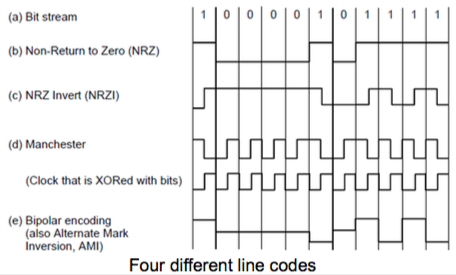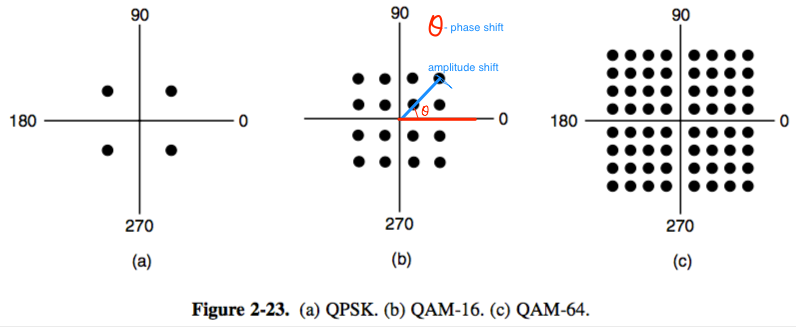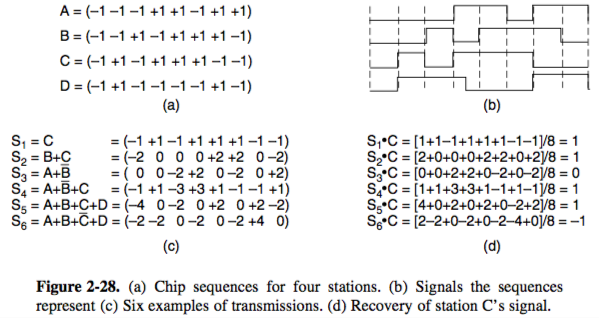Computer Networks
Table of Contents
Physical: Modulation & multiplexing
modulation schemes — send bits as signals multiplexing — share channel among users
Baseband transmission (directly convert bits to signal):
- send symbols representing bits
- symbol rate — rate at which signal changes (also “baud rate”)
- bit rate — symbol rate times bits per symbol
- NRZ (non-return-to-zero): +1V=“1”, -1V=“0”
- others:

- to decode symbols, signals need enough transitions
- problem is, after enough zeros you can’t tell when the next symbol starts
- Manchester encoding — add in clock signal by XORing with data signal
- high-to-low transition is 1
- low-to-high is a 0 (just the clock)
- NRZI — transition means 1, no transition means 0
- long runs of 1 is no problem, 0 still is
- 4B/5B — every 4 bits mapped to 5-bit pattern using fixed table
- scrambling — XOR with pseudorandom data, XOR again to decrypt
Passband transmission (regulate amplitude/frequency/phase of carrier signal to mean bits)
- Amplitude Shift Keying — two different amplitudes mean 0 or 1
- Frequency SK — two different tones mean 0 and 1
- Phase SK — wave is shifted 0 or 180 degrees to mean 0 or 1
- Quadrature Phase SK — shifts of 45/135/225/315 degrees to transmit two bits at once (four different levels)
- combine to represent more bits:
- Quadrature Amplitude Modulation (QAM-16): phase (angle with X axis on constellation diagram) and amplitude (distance from origin on constellation diagram) is modulated, can transmit 4 bits
- QAM-64 — more combinations
- constellation diagrams:

Multiplexing
- FDM (Frequency Division Multiplexing) — place channels on specific frequency bands
- WiFi and Bluetooth change frequencies — “frequency hopping”
- TDM (Time Division Multiplexing) — shares channel over time, users take turns on a fixed schedule (round-robin style)
- CDMA (Code Division Multiple Access) — narrow band signal is spread out over wider frequency band
- each bit time divided into m short intervals (‘chips’), typically 64 or 128
- each station is assigned m-bit code (‘chip sequence’)
- to transmit 1 bit, a station sends its chip sequence
- to transmit 0 bit, a station transmits negation of chip sequence.
- if more stations transmit at the same time, bits add linearly
- to recover, compute normalised inner product (station chip sequences must be known in advance)
